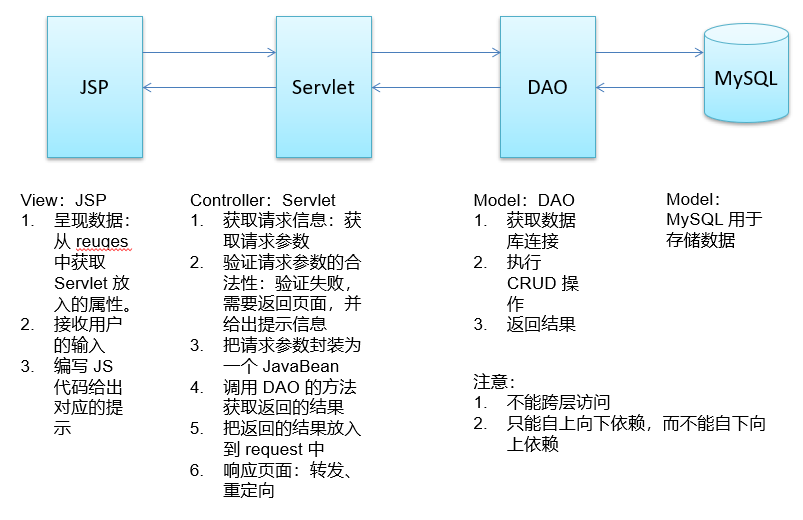MVC案例
MVC案例分析:
- 没有业务层,直接Servlet调用Dao,所以也没有业务操作。所有在DAO直接获取Connection对象
-采用MVCDs设计模式
-使用到的技术:
mvc设计模式:JSP Servlet POJO
数据库使用Mysql
连接数据库使用C3P0数据库连接池
JDBC工具使用DBUtils
页面上的提示操作使用jQuery
技术难点:多个请求如何使用一个Servlet
模糊查询
在创建或者修改的情况,验证用户名是否已经被使用,并给出提示
基本架构

1.创建数据表
Create table customers( id int primary key auto_increment, name varchar(30) not null unique, address varchar(30), phone varchar(30) );
为 name 字段添加唯一约束: alter table customers add constraint name_uk unique(name);
2.加入 C3P0 数据源
C3p0
数据库驱动的 jar 包
c3p0-config.xml
<?xml version="1.0" encoding="UTF-8"?> <c3p0-config> <named-config name="helloc3p0"> <!--提供获取连接的四个基本信息 --> <!--连接本地主机的话: jbdc:mysql://localhost:3306/test 可写成jbdc:mysql:///test --> <property name="driverClass">com.mysql.jdbc.Driver</property> <property name="jdbcUrl">jdbc:mysql://localhost:3306/aff</property> <property name="user">root</property> <property name="password">123456</property> <!-- 对数据库连接池管理的基本信息 --> <!-- 当数据库连接池中的连接数不够时,c3p0一次向数据库服务器申请的连接数 --> <property name="acquireIncrement">5</property> <!-- 初始化时的连接数 --> <property name="initialPoolSize">10</property> <!-- 维护的最少连接数 --> <property name="minPoolSize">10</property> <!-- 维护的最多的连接数 --> <property name="maxPoolSize">100</property> <!-- 最多维护的Satement的个数 --> <property name="maxStatements">50</property> <!-- 每个连接最多使用Statement的个数 --> <property name="maxStatementsPerConnection">2</property> </named-config> </c3p0-config>
3.编写 DAO、JdbcUtils工具类 和 CustomerDAO 接口
DAO
package com.aff.mvcapp.dao; import java.lang.reflect.ParameterizedType; import java.lang.reflect.Type; import java.sql.Connection; import java.util.List; import org.apache.commons.dbutils.QueryRunner; import org.apache.commons.dbutils.handlers.BeanHandler; import org.apache.commons.dbutils.handlers.BeanListHandler; import org.apache.commons.dbutils.handlers.ScalarHandler; import com.aff.mvcapp.db.JDBCUtilsC3P0; /** * 封装了基本的CRUD方法,以供子类继承使用. 当前 DAO 直接在方法中获取数据库连接 * * @param <T>:当前DAO处理的实体类的类型是什么 */ public class DAO<T> { private QueryRunner queryRunner = new QueryRunner(); private Class<T> clazz; public DAO() { Type superclass = getClass().getGenericSuperclass(); if (superclass instanceof ParameterizedType) { ParameterizedType parameterizedType = (ParameterizedType) superclass; Type[] typeArgs = parameterizedType.getActualTypeArguments();// 多个参数 if (typeArgs != null && typeArgs.length > 0) {// 参数不为空,不少于一个 if (typeArgs[0] instanceof Class) { clazz = (Class<T>) typeArgs[0]; } } } } // 返回某一个字段的值 // 例如返回某一条记录的customerName,或返回数据表中有多少条记录等 public <E> E getForValue(String sql, Object args) { Connection conn = null; try { conn = JDBCUtilsC3P0.getConnection(); return (E) queryRunner.query(conn, sql, new ScalarHandler(), args); } catch (Exception e) { e.printStackTrace(); } finally { JDBCUtilsC3P0.closeResource(conn, null, null); } return null; } // 返回T 所对应的List public List<T> getForList(String sql, Object... args) { Connection conn = null; try { conn = JDBCUtilsC3P0.getConnection(); return queryRunner.query(conn, sql, new BeanListHandler<>(clazz), args); } catch (Exception e) { e.printStackTrace(); } finally { JDBCUtilsC3P0.closeResource(conn, null, null); } return null; } // 返回对应 T 的一个实例类的对象 public T get(String sql, Object... args) { Connection conn = null; try { conn = JDBCUtilsC3P0.getConnection(); return queryRunner.query(conn, sql, new BeanHandler<>(clazz), args); } catch (Exception e) { e.printStackTrace(); } finally { JDBCUtilsC3P0.closeResource(conn, null, null); } return null; } // 封装了insert delete update操作 public void update(String sql, Object... args) { Connection conn = null; try { conn = JDBCUtilsC3P0.getConnection(); queryRunner.update(conn, sql, args); } catch (Exception e) { e.printStackTrace(); } finally { JDBCUtilsC3P0.closeResource(conn, null, null); } } }
JdbcUtils工具类
JDBCUtilsC3P0.java
package com.aff.mvcapp.db; import java.sql.Connection; import java.sql.PreparedStatement; import java.sql.ResultSet; import java.sql.SQLException; import org.apache.commons.dbutils.DbUtils; import com.mchange.v2.c3p0.ComboPooledDataSource; //使用C3P0数据库连接池 public class JDBCUtilsC3P0 { // 把池子拿到外边,连接池一个就够,需要的连接从池子中拿 private static ComboPooledDataSource cbpds = new ComboPooledDataSource("helloc3p0"); public static Connection getConnection() throws SQLException { Connection conn = cbpds.getConnection(); return conn; } public static void closeResource(Connection conn, PreparedStatement ps, ResultSet rs) { // 7.资源的关闭 DbUtils.closeQuietly(conn); DbUtils.closeQuietly(ps); DbUtils.closeQuietly(rs); } }
CustomerDAO
package com.aff.mvcapp.dao; import java.util.List; import com.aff.mvcapp.domian.Customer; public interface CustomerDAO { public List<Customer> gerAll(); public void save(Customer customer); public Customer get(Integer id); public void delete(Integer id); /** * 返回和 name 相等的记录数 * * @param name * @return */ public long getCountWithName(String name);
public void update(Customer customer);
}
4.提供 CustomerDAO 接口的实现类:CustomerDAOImpl
CustomerDAOImpl
package com.aff.mvcapp.dao.impl; import java.util.List; import com.aff.mvcapp.dao.CustomerDAO; import com.aff.mvcapp.dao.DAO; import com.aff.mvcapp.domian.Customer; public class CustomerDAOImpl extends DAO<Customer> implements CustomerDAO { @Override public List<Customer> gerAll() { String sql = "select id, name, address, phone from customers"; return getForList(sql); } @Override public void save(Customer customer) { String sql = "insert into customers(name,address,phone)values(?,?,?)"; update(sql, customer.getName(), customer.getAddress(), customer.getPhone()); } @Override public Customer get(Integer id) { String sql = "select id,name,address,phone from customers where id =?"; return get(sql, id); } @Override public void delete(Integer id) { String sql = "delete from customers where id = ?"; update(sql, id); } @Override public long getCountWithName(String name) { String sql = "select count(id) from customers where name =?"; return getForValue(sql, name); }
public void update(Customer customer){
String sql ="update customers set name = ?,address = ?,phone = ? where id = ?";
update(sql,customer.getName(),customer.getAddress(),customer.getPhone(),customer.getId()); }
5.测试CustomerDAOImpl
TestCustomerDAOImpl
package com.aff.mvcapp.test; import java.util.List; import org.junit.Test; import com.aff.mvcapp.dao.CustomerDAO; import com.aff.mvcapp.dao.impl.CustomerDAOImpl; import com.aff.mvcapp.domian.Customer; public class TestCustomerDAOImpl { private CustomerDAO customerDAO = new CustomerDAOImpl(); @Test public void testGerAll() { List<Customer> list = customerDAO.gerAll(); list.forEach(System.out::println); } @Test public void testSave() { Customer customer = new Customer(); customer.setAddress("苏州"); customer.setName("芳芳"); customer.setPhone("1451326318489"); customerDAO.save(customer); } @Test public void testGetInteger() { Customer cust = customerDAO.get(1); System.out.println(cust); } @Test public void testDelete() { customerDAO.delete(1); } @Test public void testGetCountWithName() { long count = customerDAO.getCountWithName("芳芳"); System.out.println(count); } }
目录结构






